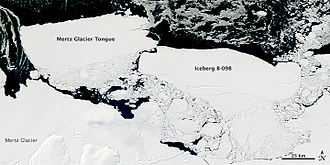Iceberg B-9

Iceberg B-9 was an iceberg that calved from the eastern Ross Ice Shelf between Roosevelt Island and King Edward VII Land in Antarctica in October 1987.[1] The iceberg measured 154 kilometres (96 mi) long and 35 kilometres (22 mi) wide with a total area of 5,390 square kilometres (2,080 sq mi).[1] It is one of the longest icebergs ever recorded.[1] The calving took place immediately east of the calving site of Iceberg B-15 and carried away Little America V.[1]
Starting in October 1987, Iceberg B-9 drifted for 22 months and covered 2,000 kilometres (1,200 mi) on its journey.[1] Initially, B-9 moved northwest for seven months before being southward by a subsurface current that eventually led to its colliding with the Ross Ice Shelf in August 1988.[1] It then made a 100-kilometre (62 mi) radius gyre before continuing its northwest drift. B-9 moved at an average speed of 2.5 kilometres (1.6 mi) per day over the continental shelf, as measured by NOAA-10 and DMSP satellite positions, and the ARGOS data buoy positions.[1] In early August 1989, B-9 broke into three large pieces north of Cape Adare.[1]
The largest of these three pieces, named Iceberg B-9B, measured 97 kilometres (60 mi) long. This new iceberg drifted toward the Mertz Glacier on the George V Coast, where it came to rest next to the glacier and remained there for eighteen years. On 12 or 13 February 2010, Iceberg B-9B collided with the giant floating Mertz Glacier tongue and shaved off a new iceberg that measured 78 kilometres (48 mi) long and 39 kilometres (24 mi) wide.[2] The two icebergs then began drifting together about 100–150 kilometres (62–93 mi) off the eastern coast of Antarctica.[2]
By December 2011, Iceberg B-9B had made its way into Commonwealth Bay and had broken up into three major pieces, parts of which were frozen to the seabed.[3] The huge iceberg prevented three tourist ships from reaching Antarctica to mark the centenary of the epic polar voyage of Australian explorer Douglas Mawson, who landed at Cape Denison on 8 January 1912 and constructed a complex of huts that remain standing to this day.[3] The three tourist ships attempted to reach the cape but had to turn back due to unusually harsh conditions caused by B-9B's position in the bay. A spokeswoman from the Australian government's Antarctic division observed, "There [are] unusual ice conditions ... affecting all the tourist ships that are going down there because the tourist ships don't have ice-breaking capabilities, and they also don't have choppers, so their ability to get anywhere near that Mawson's huts area is basically stopped."[3] Iceberg B-9B could remain in Commonwealth Bay for the next decade.[3]
See also
References
- ↑ 1.0 1.1 1.2 1.3 1.4 1.5 1.6 1.7 Keys, Harry; Jacobs, S.S.; Barnett, Don (11 June 1990). "The calving and drift of iceberg B-9 in the Ross Sea, Antarctica". Antarctic Science 2 (3): 243–257. doi:10.1017/s0954102090000335. Retrieved 23 February 2014.
- ↑ 2.0 2.1 "B9B iceberg the size of Luxembourg strikes Antarctica". Daily News. 26 February 2010. Retrieved 23 February 2014.
- ↑ 3.0 3.1 3.2 3.3 Coopes, Amy (22 December 2011). "Huge iceberg foils Mawson centenary plans". Cosmos. Retrieved 23 February 2014.